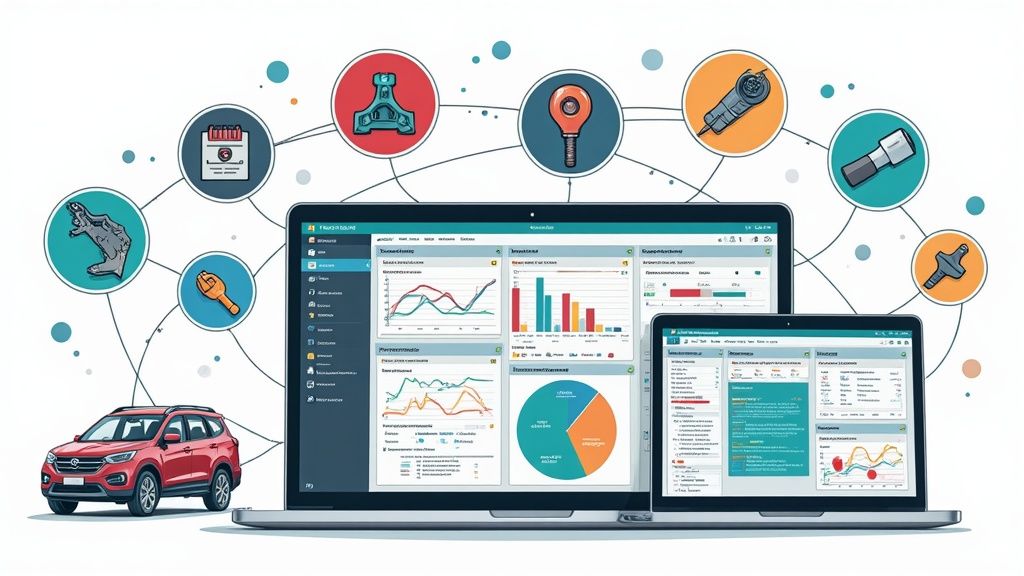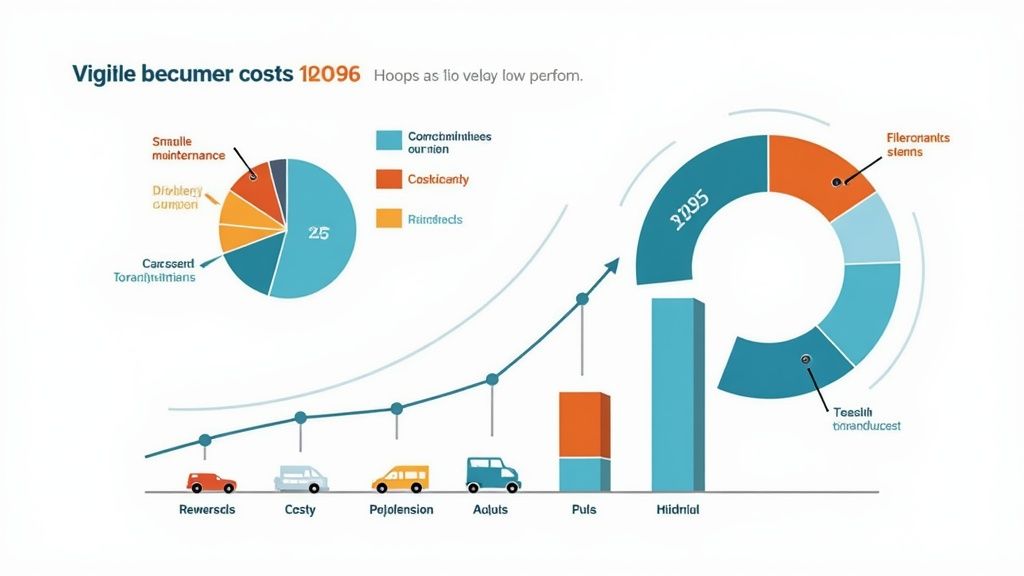
The Ultimate Guide to Software for Vehicle Maintenance: Expert Strategies for Modern Fleet Operations
Understanding the Evolution of Vehicle Maintenance Software

Managing vehicle maintenance used to be a tedious and error-prone process. Businesses had to rely on paper logs and basic spreadsheets to track repairs, predict maintenance needs, and control costs. This manual approach often resulted in missed service intervals and unexpected breakdowns that drove up operating expenses. The introduction of specialized software has completely changed how businesses handle vehicle maintenance, making it simpler and more effective.
From Spreadsheets to Sophisticated Systems
Moving from paper records to dedicated maintenance software has been like upgrading from a basic calculator to a modern computer. Platforms like Auto Service Logger now provide a single place to store and access all maintenance information, eliminating the need for physical files. These systems include helpful features like automatic service reminders that help prevent important maintenance tasks from being overlooked.
The Rise of Data-Driven Decisions
Today’s vehicle maintenance software does much more than just store digital records - it uses data to guide smart decisions. These systems track key information like mileage, fuel use, repair history, and parts replacements. By analyzing this data, managers can spot patterns, catch problems early, and create better maintenance schedules. For example, tracking fuel consumption helps identify vehicles that need attention to improve efficiency. The growing value of these insights has driven major growth in the fleet maintenance software market. As of 2023, this market reached USD 25.5 billion and is expected to exceed USD 52.4 billion by 2027. Get more details at Fleet Management Statistics.
The Benefits of Modern Vehicle Maintenance Software
Using maintenance software provides several key advantages:
- Reduced Downtime: Early warnings and predictive tools help prevent unexpected breakdowns and keep vehicles running
- Cost Savings: Better maintenance timing and early problem detection lower repair costs and help vehicles last longer
- Improved Compliance: Software helps businesses follow maintenance regulations and industry best practices
- Enhanced Productivity: Automated processes free up staff time for other important work
The shift to software-based vehicle maintenance has brought new levels of control and efficiency. Companies that adopt these tools can improve their results while making their vehicles safer and more reliable. This move toward data-driven maintenance is reshaping how the industry works and opening doors for even better solutions ahead.
Essential Features That Drive Operational Excellence

Modern vehicle maintenance software does much more than just store basic records. The right software gives companies powerful tools to boost efficiency and cut costs. When selecting maintenance software, businesses should focus on features that deliver real operational benefits.
Streamlining Maintenance Scheduling
Good scheduling forms the foundation of vehicle maintenance success. Software like Auto Service Logger helps businesses move from fixing problems after they occur to preventing them in the first place.
Key scheduling capabilities include:
- Automated reminders for routine maintenance like oil changes
- Smart scheduling based on vehicle usage, mileage, and conditions
- Prevention of missed services that could lead to breakdowns
- Extended vehicle life through consistent upkeep
Customizable Reporting and Analytics
Making smart fleet decisions requires solid data. Vehicle maintenance software provides vital metrics on repair costs, downtime, fuel use and more. Managers can spot trends, find areas to improve, and allocate resources better.
The best software offers:
- Custom reports tailored to your needs
- Easy-to-read dashboards showing key metrics
- Analysis tools to uncover insights
- Real data to guide decision making
Integration and Connectivity
Today’s fleet operations need systems that work together smoothly. Vehicle maintenance software should connect with GPS tracking, fuel monitoring, and other key tools. This creates a complete view of operations.
For example, combining GPS data with maintenance records helps:
- Plan optimal vehicle routes
- Reduce unnecessary wear and tear
- Cut down on manual data entry
- Lower the chances of record-keeping errors
Mobile Accessibility and Real-Time Updates
Quick access to information keeps operations running smoothly. Mobile-friendly software lets managers check fleet status from anywhere at any time. Real-time updates on vehicle location, maintenance needs, and potential problems help prevent issues before they cause delays.
The ability to:
- View data on any device
- Get instant maintenance alerts
- Track vehicle status live
- Make quick decisions on the go
These features show how the right software can improve fleet operations. By choosing software with comprehensive capabilities, like those in Auto Service Logger, companies can keep their vehicles running at peak performance.
Predictive Analytics and Real-Time Data in Vehicle Maintenance

Vehicle maintenance is becoming smarter and more data-driven. Predictive analytics and real-time insights are changing how businesses take care of their vehicles, moving away from fixing problems after they occur to preventing them before they happen. This approach is especially important as vehicles become more complex and businesses need better ways to maintain them.
How Predictive Maintenance Works
Predictive maintenance combines data analysis and machine learning to figure out when vehicles need service. Rather than following a fixed schedule based on mileage or time, this method monitors actual vehicle conditions using IoT sensors. For instance, the system can detect small changes in engine performance or unusual vibrations that might signal early wear and tear. By catching these issues early, businesses can avoid major breakdowns and keep their vehicles running smoothly.
Making Better Decisions with Real-Time Data
Fleet managers now have access to constant updates about how their vehicles are performing. This steady flow of information, combined with past maintenance records, helps them make smart choices about when to schedule repairs and how to assign vehicles to different routes. By using data to guide decisions, businesses can spot potential problems early and fix them before they become serious issues. This shift toward data-driven maintenance is one reason why the vehicle maintenance software market continues to grow. Learn more about market trends here: Explore the Fleet Maintenance Software Market.
Key Advantages of Modern Maintenance Technology
Using predictive analytics and real-time monitoring brings several clear benefits:
- Less Vehicle Downtime: Fixing problems before they cause breakdowns keeps vehicles on the road longer
- Better Maintenance Timing: Real-time data helps create flexible maintenance schedules based on actual needs
- Cost Savings: Catching problems early prevents expensive major repairs
- Better Safety: Quick detection of safety issues protects drivers and vehicles
- Longer Vehicle Life: Regular preventive care helps vehicles last longer
Setting Up Predictive Maintenance
To start using predictive maintenance effectively, businesses need to:
- Gather Data: Collect information from IoT sensors, vehicle systems, and maintenance records
- Analyze Performance: Use smart analytics tools to find patterns and predict possible failures
- Create Alerts: Set up notifications and maintenance recommendations based on the analysis
- Connect Systems: Link maintenance software with existing tools like Auto Service Logger for smooth operations
Businesses that choose the right vehicle maintenance software, such as Auto Service Logger, can make their fleet operations more efficient and reliable while saving money on repairs. The key is selecting tools that work well together and provide clear, useful insights about vehicle health.
Mastering Electric Vehicle Fleet Management

More companies are adding electric vehicles (EVs) to their fleets, bringing new challenges and opportunities for fleet managers. Managing an EV fleet requires specialized maintenance software to keep vehicles running efficiently. Understanding how EV fleet management differs from traditional vehicles is key to success.
Unique Maintenance Needs of EVs
EVs have different maintenance requirements compared to gas-powered vehicles. While they need fewer oil changes and tune-ups due to having fewer moving parts, certain components require special attention. Battery health monitoring is essential - specialized fleet maintenance software helps track battery performance, optimize charging patterns, and catch potential issues early. Taking a proactive approach helps extend battery life and avoid expensive replacements.
Optimizing Charging Schedules and Infrastructure
Smart charging management is crucial for EV fleets. Modern software solutions can schedule charging based on factors like electricity rates, vehicle usage patterns, and power grid capacity. This helps minimize energy costs while ensuring vehicles are charged when needed. The software also monitors charging station usage to identify bottlenecks and plan infrastructure expansion as fleets grow.
Managing Mixed Fleets: A Transitioning Landscape
Many organizations operate mixed fleets with both electric and conventional vehicles during their transition to EVs. This requires flexible software that can handle maintenance for all vehicle types. A good platform provides centralized tracking of maintenance schedules, vehicle performance data, and fleet-wide reporting. The shift toward EVs and growth of Mobility-as-a-Service are driving rapid expansion in the fleet management software market. For more details, see the Fleet Management Software Market Report.
Key Features for EV Fleet Maintenance Software
When selecting fleet maintenance software for EVs, look for these important capabilities:
- Battery Health Monitoring: Track key battery metrics including performance, degradation, and charging cycles
- Charging Schedule Optimization: Automatically manage charging based on rates, availability and grid load
- Mixed Fleet Management: Handle maintenance for both EVs and conventional vehicles in one system
- Predictive Maintenance: Use data analysis to forecast maintenance needs and prevent breakdowns
- Charging Network Integration: Connect with charging networks for seamless charging access and billing
The right software helps fleet managers handle EV-specific challenges while maximizing the benefits of electric vehicles. Solutions like Auto Service Logger provide comprehensive tools to support successful EV fleet operations during the transition to sustainable transportation.
Strategic Implementation and Change Management
Adding new vehicle maintenance software requires a step-by-step plan to get it working effectively in your organization. Just like building a house needs a solid foundation, successfully implementing new software demands careful preparation and clear steps for everyone involved.
Planning Your Implementation
The first phase is creating a detailed roadmap. This should include:
- Clear Goals: What specific maintenance problems do you want the software to fix? Get specific about targets like reducing vehicle downtime or improving maintenance scheduling.
- Team Buy-In: Include mechanics, fleet managers, and other key staff from the start to spot potential issues early. When people help shape the process, they’re more likely to embrace the new system.
- Data Transfer Plan: Map out how you’ll move your existing maintenance records into the new software without losing important information.
- Schedule and Costs: Set realistic timelines and budgets. This helps avoid delays and surprise expenses down the road.
Managing the Change Effectively
New software means new ways of working. Here’s how to help your team adapt smoothly:
- Training and Updates: Show everyone how the software helps them do their jobs better. Provide hands-on training so the team feels confident using the new tools. Think of it like learning to drive - practice leads to comfort behind the wheel.
- Test Group: Start small with a pilot team to work out any issues before rolling out to everyone. Real-world testing reveals what needs adjustment.
- Help System: Set up ongoing support to quickly answer questions and solve problems as they come up. This keeps frustration low and adoption high.
Measuring Success and Continuous Improvement
Track how well the software is working and make adjustments:
- Performance Metrics: Monitor key numbers that match your goals - like vehicle downtime, maintenance costs, and fuel use. These show if the software is delivering results.
- Team Feedback: Get regular input from users about what’s working and what could be better. Their hands-on experience reveals opportunities to improve.
- Stay Current: Keep the software updated to access new features. For example, Auto Service Logger (https://autoservicelogger.com/) includes lifetime membership so you always have the latest version.
With good planning and consistent follow-through, your new maintenance software can significantly boost your operation’s efficiency while reducing costs. The key is taking it step by step and supporting your team through the change.
Emerging Technologies Shaping the Future of Fleet Maintenance
Fleet maintenance is undergoing significant changes thanks to powerful new technologies. These advances enable proactive maintenance strategies, smarter resource use, and better operational efficiency in ways that go far beyond basic digital record keeping.
The Rise of Artificial Intelligence in Vehicle Diagnostics
AI is fundamentally changing how vehicle problems are detected and addressed. While traditional systems only alert after issues occur, modern AI-powered solutions can spot potential problems before they cause breakdowns. By analyzing data from IoT sensors and onboard diagnostics (OBD), these systems identify concerning patterns early. For instance, AI can track brake wear patterns and sensor readings to schedule maintenance before critical failures happen, helping fleets avoid costly repairs and downtime.
Blockchain for Enhanced Transparency and Security
Blockchain technology brings new possibilities for maintaining accurate, secure maintenance records. With blockchain, fleets can create permanent, tamper-proof documentation of all service work that authorized parties can access. This makes warranty claims smoother and builds trust between service providers and fleet owners. The technology also helps fight counterfeit parts by tracking component authenticity throughout the supply chain.
Autonomous Vehicle Support and its Maintenance Implications
Self-driving vehicles create new maintenance challenges and opportunities. These vehicles produce massive amounts of operational data that requires advanced systems to process effectively. Maintenance software must now handle the complex interaction between sensors, software, and mechanical parts. This includes capabilities like remote diagnostics, wireless updates, and predictive maintenance specifically designed for autonomous systems.
Preparing for the Future of Fleet Maintenance
To successfully adopt these emerging technologies, fleet managers should focus on:
- Data Integration: Creating smooth data flow between telematics, maintenance systems, and new platforms
- Software Scalability: Selecting solutions that can grow with new technologies and increasing data needs, like Auto Service Logger
- Workforce Development: Training mechanics to use AI diagnostic tools and other advanced systems
- Strategic Partnerships: Working with technology providers to test and implement new solutions
By embracing these technologies, fleet operations can become more efficient, reliable and cost-effective. Forward-thinking fleet managers who adapt to these changes will be best positioned for long-term success.
Ready to modernize your fleet maintenance? Start your free trial with Auto Service Logger today and see how our platform can optimize your operations.